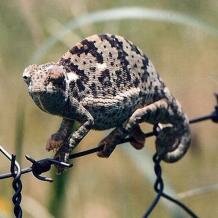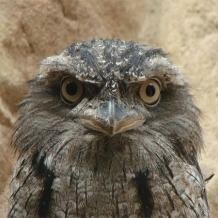Topic: Independent eye movement in fish, chameleons and frogmouths
One of the most surprising convergences amongst animals is that seen between a small fish that lives in coral sands, known as the sandlance, and the lizards known as chameleons.
 Sandlance and chameleon eyes
Sandlance and chameleon eyes
One of the most surprising convergences amongst animals is that seen between a small fish that lives in coral sands, known as the sandlance, and the lizards known as chameleons. Both creatures are capable of remarkably fast prey capture. In the chameleon this depends on the famous protrusible tongue (itself convergent) whilst in the sandlance the entire body is involved: effectively the tongue of the reptile is equivalent to the whole fish. The secret of their success lies in the fact that instead of the normal arrangement where the two eyes are yoked together, here they can operate independently (in fact much the same arrangement is seen in the mantis shrimps, also famous for their extremely rapid and powerful strike, and the pipefish).  Effectively during normal operation one eye is engaged in scanning the surrounding world whilst the other is motionless: this arrangement is believed to diminish the risk of detection by any watchful prey. In due course, the other eye is brought into action, and when the prey is detected the strike is explosively fast and highly accurate.
Effectively during normal operation one eye is engaged in scanning the surrounding world whilst the other is motionless: this arrangement is believed to diminish the risk of detection by any watchful prey. In due course, the other eye is brought into action, and when the prey is detected the strike is explosively fast and highly accurate.
An obvious difficulty of relying only on one eye is that the benefit of having two eyes that overlap and thereby confer binocular vision is lost and at first sight monocular vision for precisely judging the distance of the prey would seem to be highly problematic. Both sandlance and chameleon have converged on the same solution. Thus they retain a parallax capacity because the so-called nodal point has been moved forward of the axis of rotation of the eye. In this way the animal can judge precisely the distance it needs to strike. But this is only one of some 13 convergences documented, and amongst the most striking of the others is the pit-like fovea, a remarkable large degree of accommodation which is achieved by employing the cornea rather than the lens (and so is equipped with specific musculature), location of the eye in turrets, etc.
 Mike Land, one of the world’s leading experts on the evolution of visual systems currently remarks how “The sandlance eye breaks all the rules” (Current Biology 9, R286-R288; 1999). Indeed it does, but it is joined by the chameleon.
Mike Land, one of the world’s leading experts on the evolution of visual systems currently remarks how “The sandlance eye breaks all the rules” (Current Biology 9, R286-R288; 1999). Indeed it does, but it is joined by the chameleon.
Frogmouth binocular vision
Mention was made above of the evolution of independent eye evolution in mantis shrimps and pipefish. An interesting analogous case can be seen in the birds known as frogmouths (which also show some interesting convergences with the owls). Like all birds, frogmouths have binocular vision (and in passing we should note that this is almost certainly convergent with that of mammals), and at least in humans if the eyes start to point in different directions then this so-called strabismus may need medical attention. In the frogmouth, however, the bird is perfectly capable of binocular vision (and in this stance rivals the acuity of the owls), but if under threat the eyes will drift apart so as to afford maximum coverage.
Cite this web page
Map of Life - "Independent eye movement in fish, chameleons and frogmouths"
https://mapoflife.org/topics/topic_377_independent-eye-movement-in-fish-chameleons-and-frogmouths/
May 16, 2021

